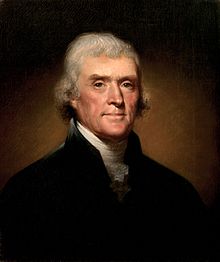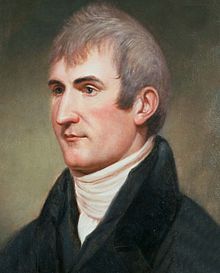January 18 —
Determined to begin the American exploration of the vast mysterious regions of the Far West, President Thomas Jefferson sends a special confidential message to Congress asking for money to fund the journey of Lewis and Clark, today in 1803.
Jefferson had been trying to mount a western expedition of exploration since the 1790s, and his determination to do so had only grown since he became president in 1801. In summer 1802, Jefferson began actively preparing for the mission, recruiting his young personal secretary, Meriwether Lewis, to be its leader. Throughout 1802, Jefferson and Lewis
discussed the proposed mission, telling no one, not even Congress, which would have to approve the funds, the nature of the monumental undertaking they were planning.
Jefferson directed Lewis to draw up an estimate of expenses. He kept his party small to avoid attention from Congress and to avoid antagonizing the Indians, so he decided to limit it to a group consisting of one officer and 10 enlisted men. Lewis carefully added up the costs for provisions, weapons, gunpowder, scientific instruments, and a large boat. The final tally came to $2,500. This isn’t a great sum, and today in 2015, it would only be about $39,821.20. The largest item was $696, this would only be about $11,086.22 in 2015 dollars, which was set aside for gifts to Indians.
Following the advice of his secretary of the treasury, Albert Gallatin, Jefferson decided not to include the request in his general proposed annual budget, since it involved exploration outside of the nation’s own territory. Instead, on January 18, 1803, he sent a special secret message to Congress asking for the money, taking pains to stress that the proposed exploration would be an aid to American commerce. Jefferson noted that the Indians along the proposed route of exploration up the Missouri River “furnish a great supply of furs & pelts to the trade of another nation carried on in a high latitude.” If a route into this territory existed, “possibly with a single portage, from the Western ocean,” Jefferson suggested Americans might have a superior means of exploiting the fur trade. Though carefully couched in diplomatic language, Jefferson’s message to Congress was clear: a U.S. expedition might be able to steal the fur trade from the British and find the long hoped-for Northwest passage to the Pacific. Despite some mild resistance from Federalists who never saw any point in spending money on the West, Jefferson’s carefully worded request prevailed, and Congress approved the $2,500 appropriation by a sizeable margin.
It no doubt seemed trivial in comparison to the $9,375,000 they had approved a week earlier for the Louisiana Purchase which brought much of the territory Jefferson was proposing to explore under American control. For comparison’s sake, that would be the equivalent of $ 149,329,481.95 in 2015 dollars. But just what did Jefferson buy for that fantastic sum? With the Louisiana Purchase the United States purchased approximately 828,000,000 square miles of territory from France, thereby doubling the size of the young republic. What was known as Louisiana Territory stretched from the Mississippi River in the east to the Rocky Mountains in the west and from the Gulf of Mexico in the south to the Canadian border in the north. Part or all of 15 states were eventually created from the land deal, which is considered one of the most important achievements of Thomas Jefferson’s presidency.
With financing now assured, Lewis immediately began preparing for the expedition. Recruiting his old military friend, William Clark, to be his co-captain, the Corps of Discovery departed on their epic exploration of the uncharted regions in spring 1804.
To purchase a signed copy of Larry Auerbach’s novel “COMMON THREADS”, Click Here
Photo courtesy of wikipedia.com



